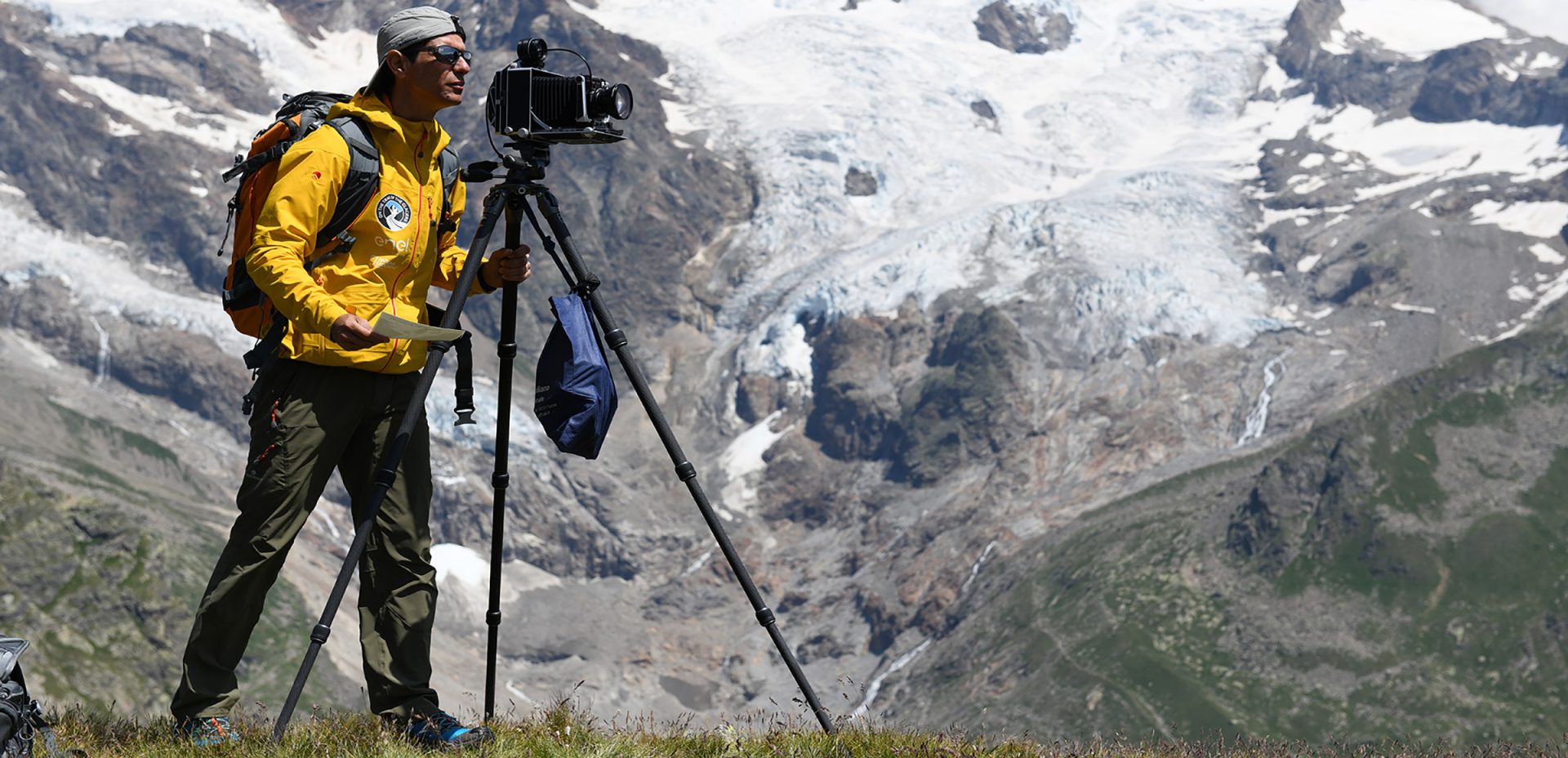With the “On the Trails of the Glaciers” project, the nature photographer Fabiano Ventura went on six expeditions to some of the world’s biggest glaciers over the course of 12 years. He took photographs which he then compared with shots from the past in order to document the effects of climate change. And his work has now appeared in National Geographic, the world’s most famous nature magazine.
Being featured in National Geographic is further evidence as to the relevance of this project. But why are glaciers so important?
Glaciers are the Earth’s thermometers, they are our climate sentinels: the state of their health is a direct indicator of the impact that human activity is having on the entire cryosphere, particularly mountain ecosystems.
Furthermore, they’re also important from an economic standpoint, both as tourist destinations and as a water source, which is now at risk due to the disrupted dynamics of the water cycle and, therefore, river flows.
In this context, repeat photography (taking pictures from the same place many years later) can be very useful in raising public awareness, because the images offer great visual immediacy.
Today, glaciers are now more widely perceived as living entities, as being part of our own ecosystem and this, to a small extent, is also thanks to my photographic project. People are increasingly becoming more aware of a fundamental message: preserving nature also means preserving ourselves.
The project started 12 years ago. How did the idea come about?
We all live in the same house, Planet Earth, and we have to respect it. And this includes the need to tell the younger generations about the effects of climate change. I’ve got two daughters, who are 11 and 13 years old, and I’m worried about the environment that they will live in.
Glaciers are ideal for making people more aware of these issues: in the collective imagination the first thing that comes to mind when speaking about climate change is melting glaciers.
The “repeat photography” technique was already quite commonly used in science: I decided to adopt it for a huge communications project.
Two of my main passions have come together in this work: on the one hand, I’ve always been passionate about vintage photos, like the beautiful examples included in the Alinari studio’s (the oldest photographic company in the world) very rich catalog; on the other, my work as a nature photographer, which focuses on mountain photography, had previously led me to observe glaciers up close, particularly as part of scientific or mountaineering expeditions.
What difficulties did you face when preparing the project?
Initially, I had difficulties finding allies in the corporate world, to secure financial backing, as well as in the academic world, to give the project more prestige and credibility.
I approached several executives of companies within the energy sector, which is the one that’s most directly involved in environmental issues, but only Enel Green Power responded positively to the call, demonstrating a far-sightedness that’s typical of its pioneering spirit.
But as soon as the project took off and started to get a bit of attention, everything changed: now researchers are often looking for us, in some cases so that they can use our photographic comparisons for their work.
I’ve always made a point of liaising with the embassies of the countries we travel to, regardless of the political climate: my project should be considered to be above politics and of interest to everyone.
In what way has Enel Green Power’s support been particularly useful?
Aside from obviously being helpful with its financial support, it’s also been very useful in other ways. EGP’s vital work in raising awareness about the project has given it greater visibility, in particular the many articles published on its site and a special section dedicated to my “personal diary.”
Furthermore, it was through EGP that I came into contact with companies from other industries which, in their turn, wanted to become part of the project by supporting it.
With EGP I immediately found that we shared many interests and values: we are both very committed to raising awareness regarding the environment and the importance of clean energy. It has been a source of great pride for me to have EGP by my side, a partner that has provided unwavering support throughout the entire project.
Companies and political decision makers can certainly play a key role in protecting the climate. But does personal responsibility also have an important role to play?
Although I am aware that most of the energy consumption is by large industries (especially the most energy-intensive ones), I believe that the problem of climate change is also cultural and social. Each and every one of us, as consumers, can therefore exercise great power through our lifestyles and the purchases we make, so we can all do our bit. For example, by choosing to use electricity from renewable sources rather than fossil fuels, or by considering the environment when choosing a means of transport. Or, by improving the energy efficiency of our homes and apartment buildings to reduce energy waste.
Each of us has to take responsibility in bringing about necessary cultural change.
You have completed six expeditions on three continents. Which environments made the greatest impression on you?
The glaciers in Alaska and Patagonia are the ones where the glacial retreat is most dramatically visible. It’s undoubtedly a consequence of global warming, but there are other dynamics at play too. Some of the glaciers in those regions are at low altitude, in some cases even descending as far as the sea, so various factors such as water salinity, ocean currents and tides have also had an impact. I think it’s important to emphasize this aspect, because the aim of my work was not to present an ideological, biased viewpoint, but to document and bear witness to this change. It was for this reason that I also photographed the rare cases where glaciers are expanding, especially in Central Asia.
And it’s because I concentrated so much effort on ensuring my work remained objective that I can now confidently confirm that, apart from a very few exceptions, glaciers are in a state of distress all over the world. After all, this is exactly what climatologists and glaciologists have been saying: I’ve now confirmed the conclusions of their research with my photos.
This was a very challenging project in many ways. What was it about you that helped you take it through to its conclusion?
Undoubtedly my incredible perseverance which, according to those who know me, is almost obsessive. Many people were surprised that, after so many years, I didn’t get bored of photographing glaciers, but I had a goal and I wanted to achieve it.
Alongside that, I also have to mention passion. I’m convinced – and this is something I always say to young people – that to succeed at something you have to do it with passion. In my case, it was a passion for mountains, for photography, and for the mission to raise awareness that I’d set for myself.
Finally, I’ve always been driven by the desire to continuously analyze things more deeply: I feel that this is a value that’s all the more important in today’s world, where we’re surrounded by “instantaneous” modes of communication.
Now that the expeditions are over, what are your plans for the future?
The expeditions are over, but the glacier project isn’t. Now it’s a matter of getting it out there even more, with new museum exhibitions, documentaries, events, publications, and conferences.
In the meantime, though, I’m also looking to the future. The focus of my next big photo project might be water, an issue closely related to the glaciers. I’m considering a 360-degree approach in order to highlight all the critical issues: rising sea levels, droughts, the seasonal cycles of rivers, water conflicts, ocean warming, coastal erosion, and plastic pollution.
Documenting such issues will be more difficult because, except for some particularly sensitive areas (such as Venice or Indonesia), the changes aren’t as quick or as obvious as they are with glaciers: it’ll certainly be a tough challenge, which is just the way I like it.
Source: Press Release


